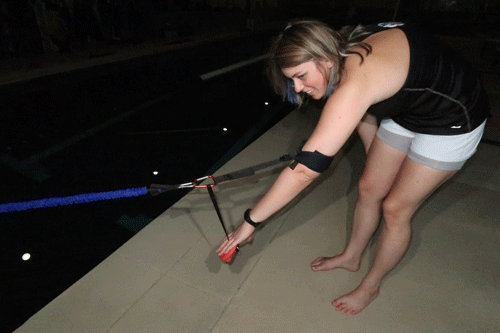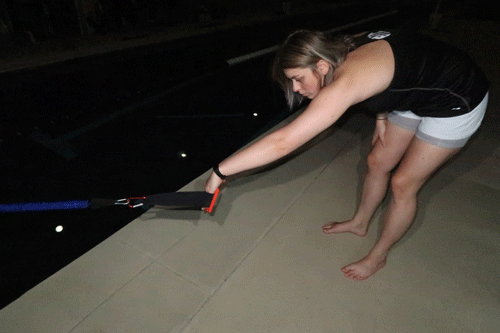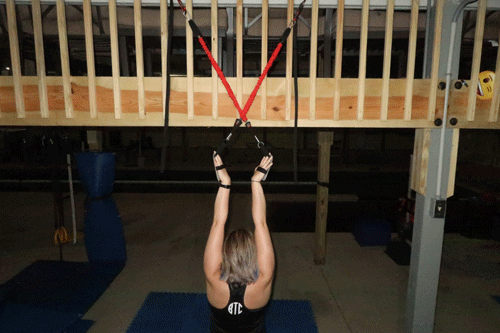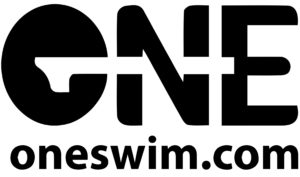courtesy ONEswim.com, a SwimmersBest brand
Let’s just skip ahead and explain: your dryland stretch cord and swim machine exercises are completely wrong for swimmers. Stretch cords with pipe handles encourage you to grab the pipe and then drop your elbows, which works the biceps and largely ignores the rest of the muscles in our swim kinetic chain. Paddles that engage from the middle of the palm also neglect the proper swim muscle chains. Push-ups and pull-ups equally work the biceps and larger muscles but neglect your swim muscle kinetic chain. With some swimmers still locked out of their pools and many more likely to be locked out in the near future, this is a very important issue for us to get right as an industry. Most of us agree that one week out of the water will take two weeks to recover and get back to where you left off. Most of us coaches have seen this process from swimmers taking a week off for vacation but how does that math work for elite swimmers that missed swimming for 2-6 months? Our team tracked a lot of metrics before COVID and had the opportunity to measure the recovery of many top-level swimmers. Our swimmers were doing normal dryland while they were out of the pool along with a lot of running and biking every day. What we found when they returned was that for many of our metrics, our elite swimmers could recover in less than a month. But we found some very key missing elements that we will address during the next likely shut-down:
- Fingertip power, palm muscles, and wrist power (the Catch phase of our stroke muscle chain) which are ultimately connected to the lats and teres minors were sadly neglected
- Recovery leg muscles (freestyle and backstroke) were also neglected and in many cases our swimmers returned with worsened technique in their flutter kicks
- Recovery muscles for body dolphins and butterfly (and upkick on finish of the Breaststroke kick) were much weaker
- As expected, breast kick muscles were also on the list of neglected muscle chains
For these four problems and a few more, it is possible that three months out may take six months to get back where we left off. But what happens if we get another shut-down?
In this article we will focus on the catch muscle chain and future articles will address other aspects of maintaining swim-specific muscle chains and technique through dryland exercises. Let’s start with WHY normal dryland exercises will not replicate the muscle chain we need to swim. It is true that pull-ups are a great measurement of a swimmer’s performance level. The more pull-ups they can do typically reflects how well they perform in their age group across the nation. But pull-ups do not mimic swimming. So while pull-ups can supplement major muscles for a swimmer who is actively swimming, pull-ups and other dryland exercises will not replace swimming and keep us from going backwards when we return to the water. This is because of the kinetic order of muscle engagement. Here is a comparison:
Push Up Kinetic Chain: 1. Bicep, 2. Lat, 3. Bicep, 4. Pecs, 5. Triceps
Pull-Up Kinetic Chain: 1. Lats, 2. Traps 3. Back 4. Tres Minor 5. Obliques
Swim Pull Kinetic Chain: 1. Trap, 2. Hand Muscles, 3. Forearm, 4. Bicep, 5. Lat, 6. Triceps
Both of these kinetic chains are grossly abbreviated and neglect to mention many other muscles but merely point out that different movements engage our muscles in different orders. A wall-out (pulling yourself out of a pool) is perhaps the closest example of a movement that correctly mimics the swim stroke muscle order of engagement. But even a wall-out can not mimic the high elbow needed in a swim stroke and, just like a pull-up, will force you to drop your elbows and depend too much on your biceps. Science has continually pointed to the high elbow or Early Vertical Forearm (EVF) as the most important technique element needed in our swim stroke. But the ability to get into an EVF is preceded by finger muscles, palm muscles and wrist muscles just to set up that high elbow in the first place. To pop our elbow into a ‘high elbow’ position we start by engaging our traps (something not replicated on normal dryland drills). But then our forward movement and power is generated from a high elbow stroke, which in turn is initiated from the hand and wrist. So grab a pipe on a stretch cord and watch all the things you don’t do properly… your traps don’t pop your elbow/shoulder up, your fingers are not used at all, your palm and wrist are locked in place, and your elbows are typically dropped. Even if you keep your palm flat over the pipe handle or use a paddle that is attached above your palm, the fingers are negated from the process entirely as are the traps. The Lats and teres minors on our back are all connected to our pinky and ring fingers so we are not fully engaging the entire kinetic muscle order of engagement without our fingers STARTING the muscle engagement of EVF in our catch.
So how do we solve such problems? Pull-ups, push-ups, planks and the rest of our dryland repertoire can not keep swimmers’ stroke muscles in shape but merely supplement IF they are actually swimming on a regular basis. Normal stretch cords either work the engagement of our stroke OR our outsweep. A cord long enough to stretch from the catch to the out-sweep in 1 stroke will do NOTHING for our catch and power phase of our stroke and merely activate the out-sweep of our stroke. Swim machines with fly wheels can engage the entire stroke of course but only if they engage our traps to pop our elbow and something to engage our fingers (particularly our pinky/ring fingers which are crucial through our entire swim kinetic muscle order).
We need a dryland device that is; a) portable, b) cost effective, c) can be used at home, d) can match different power needs, and e) truly mimics our swim strokes. The Fingertip paddle from www.oneswim.com meets all those needs. It can be used with stretch cords or their pulley devices and targets each phase of the stroke. By engaging truly from the fingertips, this paddle allows the trap muscles to quickly pop the elbow and shoulder up while putting force on the fingertip muscle chain. When the stroke starts at the fingertips, you are essentially forced to engage the proper kinetic chain.
If you drop your elbow the paddle will come off your hand to help ensure proper technique while engaging the correct muscle engagement order. If a new swimmer is having trouble dropping their elbow and losing their paddle, ONE Swim has a Stroke Right which will keep the elbow up through the initial engagement of the stroke.
ONE Swim first started to experiment with the need for improved stroke engagement tools through requests from several college and pro teams that were using their paddles and dryland tools. Many colleges wanted to have perfect dryland tools that could be attached to dive blocks which could be used during in-water swim workouts to improve both technique and overall muscle engagement. Alternating between swimming and dryland muscle engagement helps swimmers quickly learn to engage their muscles better when they swim. ONE Swim learned from their college partners and evolved this into their shortened stretch cords that allowed precise targeting of the 3 separate phases of the stroke (catch, power, and out-sweep) with their fingertip paddle. More and more colleges and pro teams have been using these tools during workouts to help swimmers learn to engage their power while swimming. But as coaches themselves for age groupers and adult master swimmers, ONE Swim’s development team started to discover the value of these tools with all levels of swimmers.
ONE Swim products further help target the stroke muscles with their DryLat Paddle. This paddle fits under the ring and pinky finger to activate the chain of muscles directly connecting these fingers to the Lats and Teres Minor muscle groups. This chain is not only essential for any stroke movements but is the key to any distance race. The longer races require more and more use of the lats as the largest muscle we use in our strokes.
To continue their development of swim-specific dryland stroke power, ONE Swim also worked on ways to target breaststroke and butterfly out-scull catch engagement. In order to engage the ring/pinky fingers as required with a ‘thumb down’ out-scull catch engagement for breast and fly, ONE swim recommends crossing stretch cords from the opposite side of the paddle. This creates a stronger engagement of the out-scull motion for these two strokes.
These improvements for our dryland stroke engagement muscles does not preclude the use of normal dryland exercises such as push-ups, pull-ups, planks, etc… Our normal dryland exercises help build and isolate the larger muscles involved. This article attempts to examine our need for more precise ways to mimic swim-specific movements throughout the year as well as during times we are out of the water. Without fingertip engagements, we are never really supplementing our stroke muscles properly. It is ideal for younger swimmers that need technique improvements but also critical for all swimmers, including our college and pro levels.
For more explanation find more information on this topic here.
DO YOU LIKE OUR SWIM EDUCATION AND GEAR? JOIN OUR NEWSLETTER.
ABOUT ONESWIM.COM, A SWIMMERSBEST BRAND
ONEswim.com is leading the way for the future of swim training equipment. The company offers a broad range of solutions for improving stroke technique, kick technique, and breathing technique. They provide swimmers, coaches, and teams with the tools they need to balance technique training with conditioning training. By combining the best drills with the best tools, the SwimmersBest products give swimmers instant tactile feedback so they can adjust their technique efficiently. The old way of having coaches constantly remind swimmers of their individual problems has proven to offer very little improvement in technique. All SwimmersBest products are designed to constantly ‘talk to the swimmers’ so they can feel the problems and make corrections. This unique approach means the swimmers are given negative feedback for incorrect stroke technique, which compels the swimmers to quickly correct the problem on their own. With a constant flow of new innovative product designs, SwimmersBest is a company that will continue to deliver solutions you need.
SWIMMERSBEST WEBSITE
SWIMMERSBEST FACEBACK
SWIMMERSBEST TWITTER
SWIMMERSBEST YOUTUBE
SWIMMERSBEST INSTAGRAM
ONEswim.com / SwimmersBest is a SwimSwam partner.






